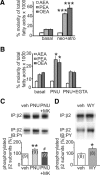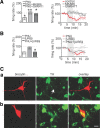PPARα regulates cholinergic-driven activity of midbrain dopamine neurons via a novel mechanism involving α7 nicotinic acetylcholine receptors
- PMID: 23554501
- PMCID: PMC6618938
- DOI: 10.1523/JNEUROSCI.4647-12.2013
PPARα regulates cholinergic-driven activity of midbrain dopamine neurons via a novel mechanism involving α7 nicotinic acetylcholine receptors
Abstract
Ventral tegmental area dopamine neurons control reward-driven learning, and their dysregulation can lead to psychiatric disorders. Tonic and phasic activity of these dopaminergic neurons depends on cholinergic tone and activation of nicotinic acetylcholine receptors (nAChRs), particularly those containing the β2 subunit (β2*-nAChRs). Nuclear peroxisome proliferator-activated receptors type-α (PPARα) tonically regulate β2*-nAChRs and thereby control dopamine neuron firing activity. However, it is unknown how and when PPARα endogenous ligands are synthesized by dopamine cells. Using ex vivo and in vivo electrophysiological techniques combined with biochemical and behavioral analysis, we show that activation of α7-nAChRs increases in the rat VTA both the tyrosine phosphorylation of the β2 subunit of nAChRs and the levels of two PPARα endogenous ligands in a Ca(2+)-dependent manner. Accordingly, in vivo production of endogenous PPARα ligands, triggered by α7-nAChR activation, blocks in rats nicotine-induced increased firing activity of dopamine neurons and displays antidepressant-like properties. These data demonstrate that endogenous PPARα ligands are effectors of α7-nAChRs and that their neuromodulatory properties depend on phosphorylation of β2*-nAChRs on VTA dopamine cells. This reveals an autoinhibitory mechanism aimed at reducing dopamine cell overexcitation engaged during hypercholinergic drive. Our results unveil important physiological functions of nAChR/PPARα signaling in dopamine neurons and how behavioral output can change after modifications of this signaling pathway. Overall, the present study suggests PPARα as new therapeutic targets for disorders associated with unbalanced dopamine-acetylcholine systems.
Figures






Similar articles
-
Peroxisome proliferator-activated receptors-alpha modulate dopamine cell activity through nicotinic receptors.Biol Psychiatry. 2010 Aug 1;68(3):256-64. doi: 10.1016/j.biopsych.2010.04.016. Epub 2010 Jun 8. Biol Psychiatry. 2010. PMID: 20570248 Free PMC article.
-
In vivo interactions between α7 nicotinic acetylcholine receptor and nuclear peroxisome proliferator-activated receptor-α: Implication for nicotine dependence.Neuropharmacology. 2017 May 15;118:38-45. doi: 10.1016/j.neuropharm.2017.03.005. Epub 2017 Mar 7. Neuropharmacology. 2017. PMID: 28279662 Free PMC article.
-
PPARα modulation of mesolimbic dopamine transmission rescues depression-related behaviors.Neuropharmacology. 2016 Nov;110(Pt A):251-259. doi: 10.1016/j.neuropharm.2016.07.024. Epub 2016 Jul 22. Neuropharmacology. 2016. PMID: 27457507
-
Physiological role of peroxisome proliferator-activated receptors type α on dopamine systems.CNS Neurol Disord Drug Targets. 2013 Feb 1;12(1):70-7. doi: 10.2174/1871527311312010012. CNS Neurol Disord Drug Targets. 2013. PMID: 23394525 Review.
-
Diverse strategies targeting α7 homomeric and α6β2* heteromeric nicotinic acetylcholine receptors for smoking cessation.Ann N Y Acad Sci. 2014 Oct;1327(1):27-45. doi: 10.1111/nyas.12421. Epub 2014 Apr 14. Ann N Y Acad Sci. 2014. PMID: 24730978 Free PMC article. Review.
Cited by
-
Orosensory Detection of Dietary Fatty Acids Is Altered in CB₁R-/- Mice.Nutrients. 2018 Sep 21;10(10):1347. doi: 10.3390/nu10101347. Nutrients. 2018. PMID: 30241419 Free PMC article.
-
The Novel Role of PPAR Alpha in the Brain: Promising Target in Therapy of Alzheimer's Disease and Other Neurodegenerative Disorders.Neurochem Res. 2020 May;45(5):972-988. doi: 10.1007/s11064-020-02993-5. Epub 2020 Mar 13. Neurochem Res. 2020. PMID: 32170673 Free PMC article. Review.
-
Sex-specific tonic 2-arachidonoylglycerol signaling at inhibitory inputs onto dopamine neurons of Lister Hooded rats.Front Integr Neurosci. 2013 Dec 19;7:93. doi: 10.3389/fnint.2013.00093. eCollection 2013. Front Integr Neurosci. 2013. PMID: 24416004 Free PMC article.
-
Regulation of PPARα by APP in Alzheimer disease affects the pharmacological modulation of synaptic activity.JCI Insight. 2021 Aug 23;6(16):e150099. doi: 10.1172/jci.insight.150099. JCI Insight. 2021. PMID: 34228639 Free PMC article.
-
Conjugated Linoleic Acid and Brain Metabolism: A Possible Anti-Neuroinflammatory Role Mediated by PPARα Activation.Front Pharmacol. 2021 Jan 8;11:587140. doi: 10.3389/fphar.2020.587140. eCollection 2020. Front Pharmacol. 2021. PMID: 33505308 Free PMC article. Review.
References
-
- Acker BA, Jacobsen EJ, Rogers BN, Wishka DG, Reitz SC, Piotrowski DW, Myers JK, Wolfe ML, Groppi VE, Thornburgh BA, Tinholt PM, Walters RR, Olson BA, Fitzgerald L, Staton BA, Raub TJ, Krause M, Li KS, Hoffmann WE, Hajos M, et al. Discovery of N+-[(3R,5R)-1-azabicyclo[3.2.1]oct-3-yl]furo[2,3-c]pyridine-5-carboxamide as an agonist of the alpha7 nicotinic acetylcholine receptor: in vitro and in vivo activity. Bioorg Med Chem Lett. 2008;18:3611–3615. - PubMed
-
- Adamczyk P, Golda A, McCreary AC, Filip M, Przegalinski E. Activation of endocannabinoid transmission induces antidepressant-like effects in rats. J Physiol Pharmacol. 2008;59:217–228. - PubMed
-
- Albanese A, Minciacchi D. Organization of the ascending projections from the ventral tegmental area: a multiple fluorescent retrograde tracer study in the rat. J Comp Neurol. 1983;216:406–420. - PubMed
-
- Andreasen JT, Redrobe JP. Antidepressant-like effects of nicotine and mecamylamine in the mouse forced swim and tail suspension tests: role of strain, test and sex. Behav Pharmacol. 2009;20:286–295. - PubMed
-
- Astarita G, Ahmed F, Piomelli D. Identification of biosynthetic precursors for the endocannabinoid anandamide in the rat brain. J Lipid Res. 2008;49:48–57. - PubMed
Publication types
MeSH terms
Substances
LinkOut - more resources
Full Text Sources
Other Literature Sources
Miscellaneous
